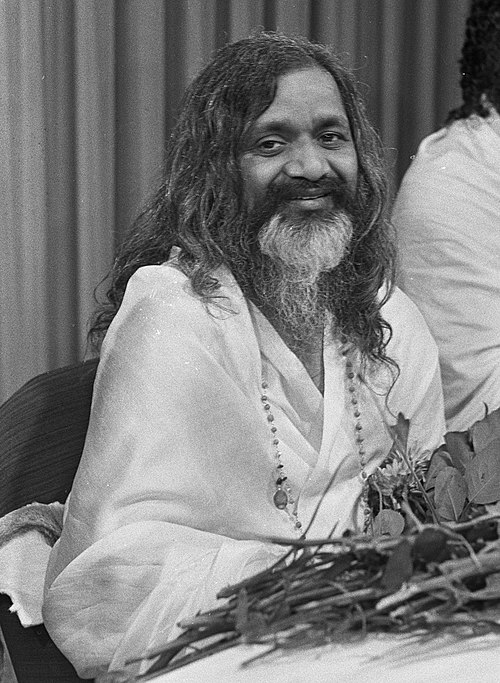Maharishi Mahesh Yogi (1918-2008) emerged as one of the most influential spiritual teachers of the 20th century, bringing ancient Vedic wisdom to the modern world through a systematic, scientifically-oriented approach. His teaching uniquely bridged the gap between ancient spiritual traditions and contemporary scientific understanding, making profound spiritual practices accessible to people of all backgrounds.
Biographical Background
Born in central India, Maharishi (meaning “great seer”) completed his physics degree before becoming a disciple of Swami Brahmananda Saraswati, the Shankaracharya of Jyotir Math. After years of study and service with his master, Maharishi began his global mission in 1955, introducing what would become known as Transcendental Meditation (TM) to the world.

Core Principles of Maharishi’s Teaching
Maharishi’s spiritual philosophy combines profound Vedic wisdom with modern scientific understanding. As he often stated:
The goal of the Transcendental Meditation technique is the state of enlightenment. This means we experience that inner calmness, that quiet state of least excitation, even when we are dynamically busy.
Consciousness as the Fundamental Reality
At the heart of Maharishi’s teaching lies the understanding that consciousness is the fundamental reality of existence. He taught that pure consciousness, or what he termed “the unified field,” underlies all of creation. As he explained:
The field of pure consciousness is the source of all creation, the source of all natural law, the source of all the laws of nature that uphold the universe in perfect order. This unified field is the unified source of all the streams of creative intelligence that are found functioning throughout nature.
The Nature of Human Consciousness
Maharishi described human consciousness as having several distinct states:
- Waking Consciousness: Our ordinary state of awareness
- Dreaming State: The state of sleep with dreams
- Deep Sleep: The state of sleep without dreams
- Transcendental Consciousness: A fourth major state of consciousness characterized by restful alertness
- Cosmic Consciousness: A permanent state where transcendental consciousness coexists with waking, dreaming, and sleeping
- Unity Consciousness: The highest state where one perceives the unified field in all of creation
- Brahman Consciousness: The ultimate state of enlightenment
As he explained:
Every human being has the natural ability to repeatedly contact this source of pure creative intelligence within himself, experience it, and unfold its unlimited potential.
The Science of Creative Intelligence
Maharishi developed what he called the Science of Creative Intelligence (SCI), which systematically explains the relationship between consciousness, intelligence, and the laws of nature. He stated:
The Science of Creative Intelligence brings to light the basic principles of nature’s functioning—the fundamental managing intelligence of the universe—and systematically cultures the direct experience of this unified field of all the laws of nature.
This science integrates subjective experience with objective scientific research, proposing that the same intelligence that governs the universe also exists within human consciousness.
The Role of Transcendental Meditation
Maharishi introduced Transcendental Meditation as a simple, natural technique to experience pure consciousness. He emphasized that TM is not a religion, philosophy, or lifestyle, but rather a mechanical technique that works regardless of belief or culture. As he noted:
The Transcendental Meditation technique is a simple, natural program for the mind, a spontaneous, effortless march of the mind to its own unbounded essence.
Key aspects of his teaching about meditation include:
The Effortless Nature of the Practice: Unlike many other meditation techniques, TM requires no concentration or control of the mind.
Regular Practice: Maharishi recommended practicing TM twice daily for twenty minutes each session.
Systematic Learning: The technique must be learned from a qualified teacher in a specific sequence of steps.
The Goal of Life
According to Maharishi, the ultimate purpose of life is to develop higher states of consciousness and achieve enlightenment. He taught that this development is natural and should be accompanied by success and fulfillment in all areas of life:
Life is not meant to be lived in suffering; life is not meant to be lived in ignorance. Life is meant to be lived in bliss consciousness, in perfect integration, in complete fulfillment.

Social and Global Applications
Maharishi’s vision extended beyond individual development to societal transformation. He introduced several large-scale programs:
The Maharishi Effect
Based on research showing that group practice of TM could positively influence social trends, Maharishi proposed that when the square root of one percent of a population practices TM together, it creates measurable improvements in society. As he explained:
The quality of life in society is a direct reflection of the quality of life of the individual. When individuals are stressed, society reflects that stress. When individuals are peaceful, society reflects that peace.
Maharishi Vedic Science
Maharishi worked to restore the complete understanding of Vedic knowledge, integrating it with modern science. This included:
- Maharishi Ayurveda: A comprehensive approach to health
- Maharishi Vedic Architecture: Principles for harmonious building design
- Maharishi Vedic Management: Applications of natural law to organization
- Maharishi Vedic Education: Development of full human potential
Scientific Research and Validation
A unique aspect of Maharishi’s approach was his emphasis on scientific validation of spiritual practices. He encouraged research on TM, leading to hundreds of studies published in peer-reviewed journals. As he stated:
The scientific research on Transcendental Meditation proves what we have been saying: regular practice of Transcendental Meditation develops pure consciousness and the integration of brain functioning.
Contemporary Relevance
Maharishi’s teachings continue to resonate in contemporary society, offering practical solutions to modern challenges:
- Stress Reduction: In an increasingly stressful world, TM provides a proven method for deep relaxation
- Mental Health: The practice offers benefits for anxiety, depression, and PTSD
- Educational Enhancement: TM programs in schools show improvements in learning and behavior
- Social Harmony: Group meditation programs continue to demonstrate positive social effects
Conclusion
Maharishi Mahesh Yogi’s contribution to world spirituality lies in his systematic presentation of ancient wisdom in modern, scientific terms. His emphasis on practical benefits, scientific validation, and universal accessibility has made profound spiritual development available to people worldwide.
His legacy continues through the global TM organization and numerous educational and research institutions. As he often said:
My mission is to bring the light of Vedic science to every individual and every nation, creating peace and prosperity for the world family.

